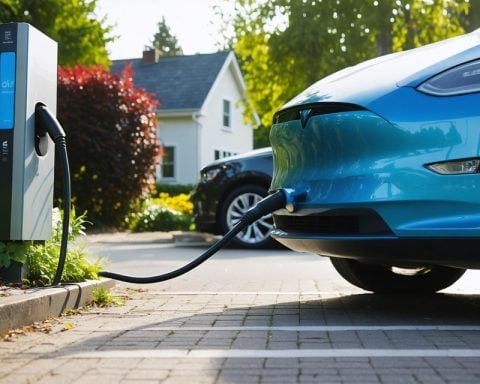- Nevada’s $38 million NEVI Program funding for EV infrastructure expansion is stalled, creating turmoil.
- Henderson, a key EV hub, experiences frustration due to scarce charging stations, causing long wait times for drivers.
- Nevada’s slower, proposal-driven approach to NEVI fund allocation faces criticism compared to other states’ swift progress.
- Challenges include rural infrastructure issues and strict federal compliance requirements, hindering Nevada’s EV growth.
- Balancing swift action with careful planning is essential as Nevada aims to accelerate its electric vehicle expansion.
Nevada’s electric vehicle scene finds itself in turmoil, as a stalled federal program puts a wrench in its expansion plans. Once poised to receive a crucial $38 million infusion from the National Electrical Vehicle (NEVI) Program, Nevada stood on the brink of a charging network renaissance. But with the program suddenly suspended, what could have powered new installations now collects dust in paperwork.
Drive through a bustling EV hub in Henderson and it’s a scene of quiet frustration. Drivers jostle for spots, electric cables as battlegrounds. One driver recounts navigating early morning hours just to beat the crowd—charging stations are scarce, and patience runs thin. Some find themselves waiting for hours, while others, determined to escape conflict, attempt nighttime charges under the muted glow of streetlights.
Nevada’s oversight of the NEVI funds draws heavy fire. Where other states swiftly rolled out their grants, offering gas station owners the chance to join the electric age, Nevada’s slower, proposal-driven approach left it stranded. The criticism is sharp: with such a pressing need, Nevada must move faster.
Nevada cites challenges—ranging from rural infrastructure deficiencies to compliance with stringent federal guidelines—as reasons for the impasse. Yet, the fleeting moment remains a sore point, as ideas about transparency and rigor clash with a tangible need for progress.
The takeaway is clear: in the rush towards a greener future, balancing swift action with careful planning is crucial. As electric vehicles multiply, Nevada finds itself at a pivotal juncture; the state’s commitment to overcoming these hurdles will determine if it can finally hit the accelerator on its EV ambitions.
Shocking Delays in Nevada’s EV Charging Network: What’s Next?
How-To Steps & Life Hacks for EV Charging in Nevada
1. Plan Ahead: Use apps like PlugShare or ChargePoint to locate available charging stations ahead of time.
2. Peak Hours Strategy: Try to charge your vehicle during off-peak hours, such as early morning or late at night, to avoid long wait times.
3. Home Solutions: Consider investing in home charging equipment if possible, which can mitigate the challenges of finding public charging stations.
4. Charging Etiquette: Be mindful of time limits and charging needs of others; don’t leave your vehicle plugged in longer than necessary.
Real-World Use Cases
– Fleet Management: Companies can use EVs for short-haul trips to reduce emissions and fuel costs. For example, cities like Reno can deploy electric buses for public transportation.
– Tourism Boost: By expanding charging infrastructure, Nevada could attract eco-conscious tourists who travel to natural landmarks like Las Vegas and Lake Tahoe by EV.
Market Forecasts & Industry Trends
The global electric vehicle market is projected to grow significantly, with a compound annual growth rate (CAGR) of about 21.7% from 2021 to 2030. Nevada, though currently lagging, has the potential to attract tech-savvy demographics by enhancing its EV infrastructure.
Reviews & Comparisons
– Comparative Performance: States like California have successfully implemented extensive charging networks. Nevada can learn by modeling such frameworks, including public-private partnerships.
– Infrastructure Analysis: Compared to its peers, Nevada’s delayed action is notable. An analysis of New York shows swift rollouts despite similar challenges, highlighting Nevada’s room for improvement.
Controversies & Limitations
The NEVI program’s suspension in Nevada is a subject of controversy. Critics argue that competition rather than delay is needed to push innovation. The resulting limitation strains both public patience and the feasibility of meeting EV adoption goals.
Features, Specs & Pricing
– Charging Speed: Nevada needs to focus on installing more DC fast chargers which can recharge a vehicle in 30 minutes, versus the slower Level 2 chargers.
– Cost: Average installation costs for Level 2 chargers can range from $2,500 to $3,000, while DC fast chargers can be much higher.
Security & Sustainability
– Data Privacy: With more charging stations, ensuring secure data transmission related to transactions and usage is vital.
– Renewable Integration: Charging stations powered by solar panels could enhance Nevada’s sustainability goals.
Insights & Predictions
– Leadership Change: Expect legislative pressures for quicker deployment of funds once NEVI resumes.
– Eco-Friendly Policies: Nevada may introduce incentives for private installations to compensate for public shortages.
Tutorials & Compatibility
For users new to EVs, user-friendly apps like Tesla’s interface allow seamless operation and location of compatible charging stations. Increasing compatibility and integration with third-party chargers can further ease the transition.
Pros & Cons Overview
Pros:
– Reduced emissions
– Cutting-edge technology
– Growing support framework
Cons:
– Long wait times
– Inconsistent infrastructure
– Initial cost for consumers
Quick Tips for Every EV Driver in Nevada
– Stay Updated: Follow Nevada’s Department of Transportation updates on the NEVI program’s status.
– Join Forums: Engage with Nevada EV groups online where fellow drivers discuss station experiences and readiness.
For more updates on electric vehicles, visit the official NV Energy homepage. By being proactive and informed, Nevada residents and visitors can turn current EV challenges into opportunities for a cleaner, greener state.













